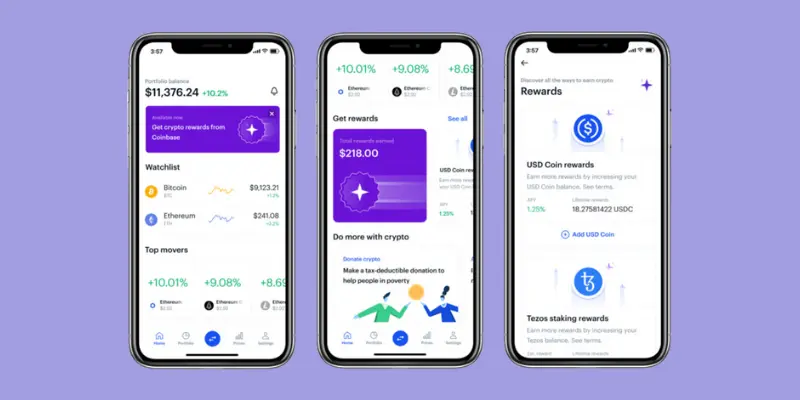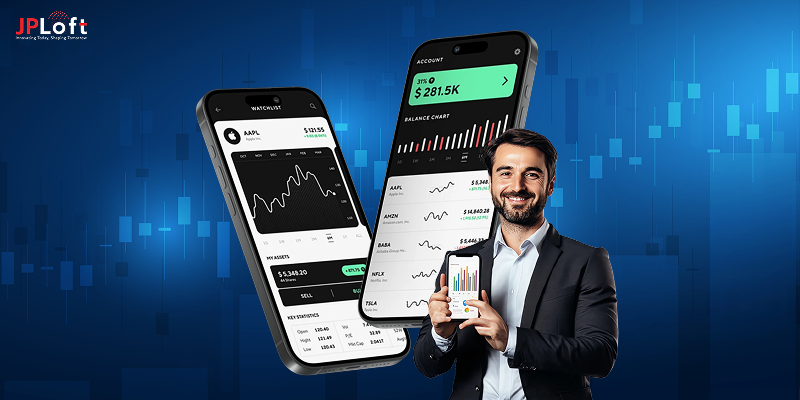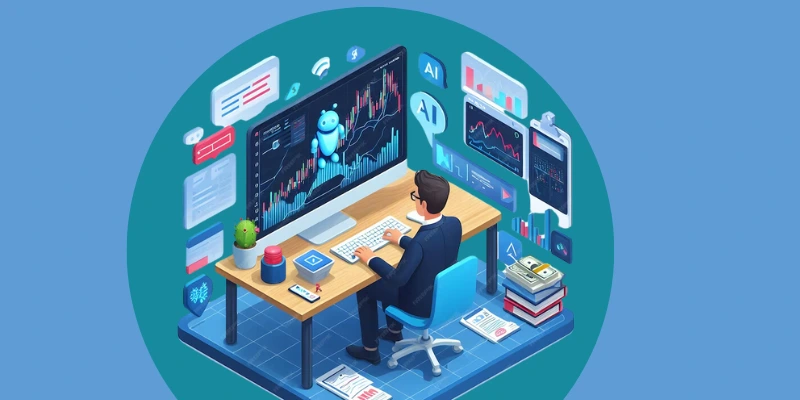In recent times, trading apps that are available online have become popular because of their simplicity of use and the ability to trade stocks. There are no longer lengthy phone calls or forms since people can manage their portfolios on mobile devices.
Popular fintech applications such as Robinhood have created an entirely new world. With over 22 million users registered, the application has revolutionized the market for financial services. One factor that makes Robinhood an attractive investment option is its zero-commission strategy.
If you are an entrepreneur who wants to build a stock exchange application similar to Robinhood, you're at the right place. This blog will discuss all aspects of features, costs, and more.
Statistics on the Robinhood and Stock Trading App Market
Before creating your app for trading stocks, check out the following stats. Understanding these FinTech and e-trading app market statistics will help you make better choices.
-
A study released by Robinhood shows that revenue derived from transactions for 2021 has risen to $1.40 billion.
-
The active users per month for Robinhood app have grown to 17.3 million by 2021.
-
This Robinhood app has more than 4M ratings and is currently in 24th place in the finance category on the Apple App Store.
-
According to Google Consumer Insights, the stock and investing app search volume has increased by 115% year-over-year.
-
As per Statista, in August 2021, the number of monthly most active members of Robinhood trading app was 7.3 million.
-
According to a study by SensorTower, the app for asset management records installations of more than 35 million downloads in the second quarter of 2021 across the USA, a more than 198 percent increase from the previous quarter.
The potential for on-demand trading app development services is bright. This is a perfect opportunity to create an app for trading stocks.
Must-Have Features of Trading Apps
Stock trading applications are loaded with numerous features that meet customers' needs. Here are a few of the most popular features you can include in the Robinhood-like app you have:
User Authentication
If you create an application that allows you to trade stocks, ensure you have a secure and simple login option. This will enable users to log in using many options, such as telephone numbers, email addresses, usernames, passwords, biometrics, and official networks.
Guidelines and trade protocols approved by the government and regulations must be part of the authentication. It is essential that users comply with the guidelines whenever they establish and use accounts.
Dashboard
The dashboard is a crucial element that makes Robinhood a clone. It is essential to hire stock trading app developers to design a practical and easy-to-use dashboard for your application. Be sure that your users can connect to the dashboard from the app's home page.
Important information such as the watchlist, balance of the order status, and other user profile details should appear on dashboards. Be mindful not to fill the design with too much data. Be sure to be concise and easy to understand.
Investment Portfolio Management
With portfolio management, users can monitor and manage their investments. They can also review and edit their portfolios, receive notifications of any changes to their portfolios, and access data collected in previous years. Once they know the details of their portfolios, users can make well-informed decisions about them.
Stock Trading Feature
The software you use to trade should have this fundamental function: users can purchase or sell their stock. Furthermore, the application should be easy to use for placing trades. It must provide features such as live market information that is updated in real-time, different types of orders, the option of setting price goals, and stop-loss limits. This can simplify the process of trading stock holdings and selling and buying.
Search and Filter
Search and filtering allows users to locate stocks in a short time they're searching for. Users should be able to filter their search based on market capitalization, industry, or sector. Integrating this feature into the application you are using will aid the users in quickly identifying and tracking the stocks they want to invest in.
Watchlist
Users can log into an account known as a "watchlist" to track their most beloved stocks and receive alerts when the market fluctuates. They can also change their stocks, see the information in real-time, and create custom alerts. By keeping track of their most beloved stocks, users stay current on market developments and can make quick trade-making decisions.
News and Media
To trade efficiently, market participants should be informed about the latest changes and developments. To do this, it is essential to include a section dedicated to news and other media, including relevant videos, content, or podcasts. A complete content feed for media and news lets users stay informed about the latest market developments.
Transaction Management
Your application should have an automated system to handle transactions. It should have features like transaction history documents and modifications to order status, as well as the ability to change or cancel orders. What's more, this feature also offers the possibility of setting up individual alerts and notifications for certain transactions at specific times.
Direct Order Routing
It's an advanced function that lets traders trade directly on the exchange without intermediaries. It also lets you immediately put in stop-loss, market limits, and limit orders and provides updates on the status and market information. This feature allows traders to ensure that transactions are carried out quickly and effectively.
Push Notifications
Reminders and push notifications are real-time alerts that notify users of trade or market modifications. If you decide to include the push notification feature in your app, ensure it has features such as custom alerts for price targets or stop-loss events and reminders for upcoming events.
How to Craft a Robinhood-like App: Step-by-Step Process
The development of a stock trading application like Robinhood can be a thrilling idea, but understanding the numerous complexities involved could be a daunting task. Let's look at essential steps to develop your application and make sure you're conscious of costs:
Define Your Scope:
-
User Personas: Who is the targeted segment? Are they new investors, experienced traders, or new to the stock market? Your understanding of the preferences and needs of your customers designs your stock trading applications and wealth management software.
-
Basic features: Prioritize commission-free trading, easy-to-use GUI shares fractions, and an analysis tool that is basic to analyze data from technical sources. The software's features can be expanded in line with the budget and user feedback.
-
Strategies for Monetization: Knowing how to earn money is crucial to building a profitable app. Examine revenue models, such as premium subscriptions for top features, margin loans, or financial institution assistance.
Choose Your Development Approach:
-
Native or Cross-platform: Depending on the platform you decide to use to develop your app to trade stocks, you can opt to build your app natively instead of developing on cross-platform platforms for your app. Native app development gives you greater performance. However, separate programming is required for each operating system (iOS and Android ).
-
Multi-platform: On the other hand, making a cross-platform application using Flutter, an SDK based on Google that accelerates the development process by establishing an entire codebase and then using it to build both Android and iOS applications. This can mean you'll save 40% of the cost of development and time while guaranteeing user-friendly and high performance for your trading app. Additionally, you don't have to be an expert at code. You can work with a flutter creator from an established fintech development firm.
Partner with an associate of the Right Stock Trading App Development Company:
To ensure you're working with the right stock trading app development company that can help you with the process of developing your application process, look for these characteristics:
-
Experience: Find competent staff members or recruit Fintech developers to develop robust and adaptable financial software.
-
Clear Communication: Ensure the entire team adheres to an open and transparent communication process and works together throughout the app's development.
-
Cost-Effective Solutions: Study the different engagement models and choose the one that best suits your requirements. Pricing models include fixed charges, hourly rates, and hybrid models.
Navigate Regulatory Compliance:
If you are developing trading apps for stocks like Robinhood, it is essential to consider compliance with regulatory needs to avoid legal issues. What rules should you be thinking about? Let's explore.
-
Financial Regulations: Identify the relevant laws and regulations that could apply to a specific target market. For instance, each country has its unique financial management guidelines and regulations. Find relevant laws, including KYC/AML and FINRA licenses for your primary countries.
-
Security and Privacy: Implement secure protocols for your data and ensure you can adhere to privacy laws such as GDPR and CCPA.
-
Legal counsel: Get professional legal advice or guidance to ensure that the application you submit complies with all the laws and regulations.
Testing and launching Confidently:
-
Comprehensive Testing: It is crucial to test your app across various platforms to ensure that it is in good working order and meets users' needs. This will help you identify problems and ensure the application's reliability and stability.
-
Beta testing: Before you fully launch your app, it is recommended that you test beta versions to collect valuable feedback from users and then make improvements to the app you are in line with. This could increase the happiness of your users as well as make modifications.
-
Phased Launch: Another option is to consider an accelerated launch, where you gradually release new features and functions. This will accelerate acceptance and also allow you to fix any bugs or issues that may arise.
Although prices may differ, it is possible to build an effective application without a budget issue by focusing on the most important elements and forming strategic partnerships.
Best Practices for Trading App Security
Substantial financial transactions and investments identify investors' assets in apps, which are particularly vulnerable to cyber-attacks, theft, and hacking. Be careful when dealing with sensitive financial data and transactions. Make sure to follow these security guidelines when creating stock trading app development solutions to eliminate the risk of security from your company.
Effective Security Practices
Adhere to standard security procedures to safeguard your application from security threats like SQL injection, Cross-Site Scripting (XSS), and Cross-Site Request Forgery (CSRF). Modify the codebase to patch vulnerable areas.
Data Encryption
Data Encryption implements algorithms that convert data into codes using protocols like HTTPS. These codes are secure and are only available to the person who is intended to receive them. They shield sensitive data from being accessed when communicating between the server and the application. It also safeguards sensitive information that is stored in the database to guard against unauthorized access to information.
Two Factor Authentication
Logging in with an accessible username and password will not be enough to keep your trading application secure from cyberattacks. It is imperative to implement a two-factor authentication feature. This feature will let investors sign in using their email addresses, telephone numbers, fingerprints, and Face ID. This will ensure secure security for trading, communication, and transactions.
User Data Protection
Conserve the most essential information about users and employ data minimization to avoid overstuffing storage space and data leaks. Be sure to follow the rules to protect data, including GDPR (General Data Protection Regulation) and CCPA (California Consumer Privacy Act), to protect users' privacy. Install a reliable surveillance system and logs that can promptly detect and fix any security concerns.
Role-Based Access Control
RBAC, also known as Role-Based Access Control, is a security method that restricts access to particular users according to the specific roles assigned to them. In this RBAC application, access rights are granted according to the role given to each user. This method blocks access rights for all users. It is an organized and flexible way of controlling access rights and access rights in the application.
Regular Security Audits
Conduct penetration tests and regular security audits to determine and rectify any vulnerabilities in your app's structure or code. Regular security audits can help avoid cyberattacks, bugs, hacking, phishing attacks, data leaks, and unauthorized access.
Implement Secure Session Management
Secure session management procedures to ensure smooth operation and prevent forgery and theft. Utilize session tokens, set timeouts for session sessions, and prolong inactive sessions while controlling the app's operations and activities.
Cost to Build an App Like Robinhood?
In the beginning discussion, the price to develop an app such as Robinhood could range from $10,000 to $12,000. However, what exactly are the features built for this amount? That's why there are numerous variables that affect the cost of developing an app.
If you want to develop an app that trades stocks, such as Robinhood, in the long run, the total development cost could range from $20,000 to $50,000 based on market reports. However, it won't be said that you can't create an app with less than $20,000. The price won't exceed $50,000.
Making an app is similar to purchasing an automobile. While you analyze various variables before buying a car, it is equally important to know the factors that determine the price of developing an app.
To understand the cost of creating an application like Robinhood, you may need hiring experts to guide you through all the intricacies and estimate the price depending on the specific needs of your business.
Factors Affecting the Cost to Create An App Like Robinhood
Making an app similar to Robinhood is a complex process involving many factors impacting overall development costs. Although it's difficult to give an exact amount, here are the aspects that impact the price of building an app similar to Robinhood.
Here are several significant elements that influence the overall development cost:
Complexity and Features: The level of complexity of the features you'd like to include within your app will influence the price. Apps with extremely complicated features will require skilled developers and will take a lengthy time to develop, resulting in higher prices.
Here is an estimate of the significant features and their cost breakdown
Platform(s) and Devices: Development for one device (iOS or Android) is generally more affordable than creating apps for both platforms simultaneously. If you hire a React native app developer, you could reduce the cost of your app development by up to 40%.
As React Native is one of the top cross-platform programming languages, it has simplified the creation of an application that runs across multiple platforms with the same codebase. The cost of building two native apps is between $30,000 and $40,000, while a cross-platform application could be priced between $18,000 and $20,000, depending on the degree of complexity.
UX/UI of the App: An attractive and user-friendly interface is essential for a successful trading app. The cost of the app will be determined by the level of complexity, the number of screens, the use of custom animations, and the requirement for expertise in UI/UX. The cost is based on the average.
Backend Development: Creating an efficient and scalable backend infrastructure is crucial for managing transactions, user data, market data, and other functions. The system's complexity and server requirements will affect development costs.
Security and Compliance: Security and compliance are essential regarding user information and financial transactions. Implementing rigorous security procedures and checking compliance to the regulations such as KYC (Know Your Customer) and AML (Anti-Money Laundering) could require additional effort in development and expense.
Third-Party Integrations: When you intend to integrate third-party trading software development services, like payment gateways, market data providers, and identity verification, you might incur additional expenses for integration efforts and the possibility of subscription or licensing fees.
Testing and Quality Assurance: Quality assurance and rigorous testing are vital to ensuring performance, stability, and security. This can include automated or manual tests, fixing, and providing a seamless user experience on different devices.
Regular Maintenance and Updates: After initial development, the software will undergo ongoing maintenance and updates, bug fixes, and compatibility improvements. The cost for maintenance is contingent upon the amount of time and the number of updates.
These are the most important aspects that impact the overall cost of developing an app. However, when estimating the cost of app development, consider how the application's functions and functions are the most expensive part of the development.
Conclusion
Financial innovation is coming to mobile Robinhood's successes have proven that. Robinhood has also revolutionized investing and developed a user-friendly experience, opening the door to an entirely new class of apps for trading stocks.
It's an opportunity to be part of the new wave of innovation. Whether you're an old-fashioned brokerage company that needs to be modernized or a fintech start-up with a vision, a custom stock trading application can help you increase your business and attract a new set of investors.











Share this blog